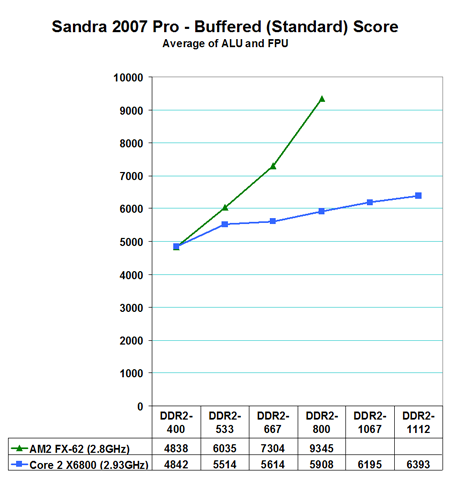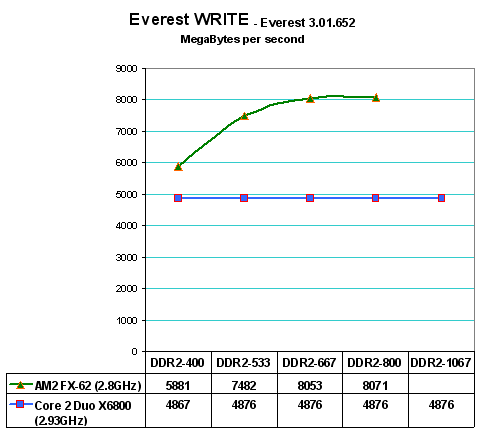Memory Bandwidth and Scaling
Everyone should already know that memory bandwidth improves with increases in memory speed and reductions in memory timings. To better understand the behavior of AM2 and Core 2 Duo memory bandwidth we used SiSoft Sandra 2007 Professional to provide a closer look at memory bandwidth scaling.

The most widely reported Sandra score is the Standard or Buffered memory score. This benchmark takes into account the buffering schemes like MMX, SSE, SSE2, SSE3, and other buffering tools that are used to improve memory performance. As you can clearly see in the Buffered result the AM2 on-chip memory controller holds a huge lead in bandwidth over Core 2 Duo. At DDR2-800 the AM2 lead in memory bandwidth is over 40%.
As we have been saying for years, however, the Buffered benchmark does not correlate well with real performance in games on the same computer. For that reason, our memory bandwidth tests have always included an UNBuffered Sandra memory score. The UNBuffered result turns off the buffering schemes, and we have found the results correlate well with real-world performance.

The Intel Core 2 Duo and AMD AM2 behave quite differently in UNBuferred tests. In these results AM2 and Core2 Duo are very close in memory bandwidth - much closer than in Standard tests. Core 2 Duo shows wider bandwidth below DDR2-800, but this will likely change when the AM2 controller matures and supports values below 3 in memory timings as the Core 2 Duo currently supports.
The Sandra memory score is really made up of both read and write operations. By taking a closer look at the Read and Write components we can get a clearer picture of how the two memory controllers operate. Everest from Lavalys provides benchmarking tools that can individually measure Read and Write operations.

The READ results are particularly interesting, since you can see that the READ component of Core 2 Duo performance is much larger than the WRITE results on Core 2 Duo. This is the result of the intelligent read-aheads in memory which Intel has used to lower the apparent latency of memory on the Core 2 Duo platform. Actual READ performance on Core 2 Duo now looks almost the same as AM2 to DDR2-533. AM2 starts pulling away in READ at DDR2-677 and has a slightly steeper increase slope as memory speed increases. The increases in READ speed in Core 2 Duo are a result of the intelligent read-aheads in memory. Performance without this feature would show Core 2 Duo much slower in READ operations than AM2.

This is most clearly illustrated by looking at Everest Write scores. Memory read-ahead does not help when you are writing memory, so core 2 Duo exhibits much lower WRITE performance than AM2 as we would expect. This means if all else were equal (and it isn't) the AM2 would perform much better in Memory Write tasks. Surprisingly the WRITE component of Core 2 Duo appears a straight line just below 5000 MB/s. AM2 starts at 5900 at DDR2-400 and WRITE rises to around 8000MB/s at DDR2-667. Write then appears to level off, with higher memory speeds having little to no impact on AM2 WRITE performance.
Everyone should already know that memory bandwidth improves with increases in memory speed and reductions in memory timings. To better understand the behavior of AM2 and Core 2 Duo memory bandwidth we used SiSoft Sandra 2007 Professional to provide a closer look at memory bandwidth scaling.

The most widely reported Sandra score is the Standard or Buffered memory score. This benchmark takes into account the buffering schemes like MMX, SSE, SSE2, SSE3, and other buffering tools that are used to improve memory performance. As you can clearly see in the Buffered result the AM2 on-chip memory controller holds a huge lead in bandwidth over Core 2 Duo. At DDR2-800 the AM2 lead in memory bandwidth is over 40%.
As we have been saying for years, however, the Buffered benchmark does not correlate well with real performance in games on the same computer. For that reason, our memory bandwidth tests have always included an UNBuffered Sandra memory score. The UNBuffered result turns off the buffering schemes, and we have found the results correlate well with real-world performance.

The Intel Core 2 Duo and AMD AM2 behave quite differently in UNBuferred tests. In these results AM2 and Core2 Duo are very close in memory bandwidth - much closer than in Standard tests. Core 2 Duo shows wider bandwidth below DDR2-800, but this will likely change when the AM2 controller matures and supports values below 3 in memory timings as the Core 2 Duo currently supports.
The Sandra memory score is really made up of both read and write operations. By taking a closer look at the Read and Write components we can get a clearer picture of how the two memory controllers operate. Everest from Lavalys provides benchmarking tools that can individually measure Read and Write operations.

The READ results are particularly interesting, since you can see that the READ component of Core 2 Duo performance is much larger than the WRITE results on Core 2 Duo. This is the result of the intelligent read-aheads in memory which Intel has used to lower the apparent latency of memory on the Core 2 Duo platform. Actual READ performance on Core 2 Duo now looks almost the same as AM2 to DDR2-533. AM2 starts pulling away in READ at DDR2-677 and has a slightly steeper increase slope as memory speed increases. The increases in READ speed in Core 2 Duo are a result of the intelligent read-aheads in memory. Performance without this feature would show Core 2 Duo much slower in READ operations than AM2.

This is most clearly illustrated by looking at Everest Write scores. Memory read-ahead does not help when you are writing memory, so core 2 Duo exhibits much lower WRITE performance than AM2 as we would expect. This means if all else were equal (and it isn't) the AM2 would perform much better in Memory Write tasks. Surprisingly the WRITE component of Core 2 Duo appears a straight line just below 5000 MB/s. AM2 starts at 5900 at DDR2-400 and WRITE rises to around 8000MB/s at DDR2-667. Write then appears to level off, with higher memory speeds having little to no impact on AM2 WRITE performance.










118 Comments
View All Comments
Calin - Tuesday, July 25, 2006 - link
I hate to rain on your parade, but the E6x00 and X6800 (Extreme) desktop CPU won't see a dual socket mainboard - for that you must use Xeons.As for multisocket, it was a niche market when multicore was not available, it is (maybe even more so) when multicore is available. Quad core will reduce it even more for desktop use. As for Intel knowing multicore is the future, I think their quad core will be on market before AMD's quad core - and if you are worrying about performance, keep worrying - we can small talk about this and that all day long.
AMD is in a much weaker position now - they must sell processors at half (or less) the profit they sold them until now, and the future is grim if you regard their profits. They could survive a long way, but they again are the budget CPUs, the best choice for small money.
As for 64-bit, you are certainly right - just that right now, 64-bit is of little use on desktop, the operating systems suffer from drivers problems, 64-bit applications are few and far between. You might need 64-bit and profit from it, but you are a minority now.
Ingas - Tuesday, July 25, 2006 - link
Maybe AMD in trouble.But not because of Core 2 Duo, but because of Woodcrest.
AMD alwais said that only server processors giving profit.
So ...
With Dell's AMD Now - maybe it's not trouble for AMD at all.
Calin - Wednesday, July 26, 2006 - link
Dell will only build enough AMD gear as not to lose business with their customers that WANT AMD gear. Even with higher performance losses on 4 sockets, Xeons Core2Duo (which are faster to boot) might put a fair fight against AMD - and then customers will choose based on other things than performance.I agree AMD Opteron scale better - but they start scaling from a lower performance
duploxxx - Wednesday, July 26, 2006 - link
do you really think you're sure about that. compare the same speed of opteron vs woodcrest and you will talk different.. i know how it performs because i have a wood es system on my table. and i am not a big fan of hexus reviews but look at the site, the wood isn't so bright and shining knowing again it is a compare of 3.0 vs 2.6.mesyn191 - Tuesday, July 25, 2006 - link
For 2S systems Intel will have the lead til' K8L becomes available, but for 4S AMD will have Intel beat and that lead will only increase when K8L becomes available. They're definitly gonna be hurting profit wise, but they'll be doing better than they were when it was P4C vs. AXP and they got through that so I see no reason to worry about them going into bankruptcy before K8L comes out in volume.sld - Tuesday, July 25, 2006 - link
What is wrong with a desktop user looking at the performance of a desktop cpu?When you can get a 4x4 at the same price/performance ratio curve as a Core 2 Duo, do please inform me.
I still believe AMD vs Intel is a David vs Goliath, although like the real David, AMD is beginning to get complacent with just a taste of power, and Core 2 is just what it needs to wake up and start dropping prices. :)
sld - Tuesday, July 25, 2006 - link
I forgot to mention that Core 2 is worth a consideration over the K8, but if we really want to punish Intel for being the monster they are, we should institute a complete boycott over the purchase of their existing Netburst inventory. That should hurt them quite a bit...Picture a scenario where new chips go straight out of the warehouse and into the embracing arm of a bulldozer. When it comes to that point do you think they will resort to giving the cpus away?
mattsaccount - Tuesday, July 25, 2006 - link
Are the Super Pi scores on page 7 right? The text says Conroe wins everything, but the Super Pi bench is reversed (I'm guessing the colors are just backward)Wesley Fink - Tuesday, July 25, 2006 - link
Since the lower score is better on Super Pi (faster time) the scales are reversed - from zero at the top to 90 at the bottom. The colors and values are correct, just upside down so the lowest score (fastest) is on the top like the other charts. You apparently caught that while I was typing this explanation :)highlandsun - Tuesday, July 25, 2006 - link
Have you got 32M digit results for Super Pi? Curious to see if that will exceed Conroe's cache and therefore reflect the real memory bandwidth. Also, results for running two copies of Super Pi at once on each system.